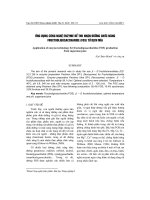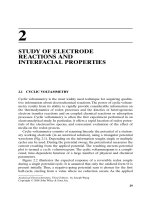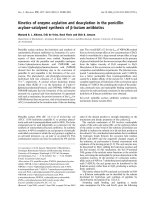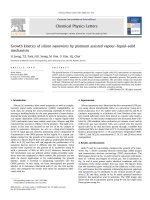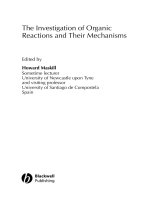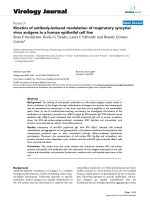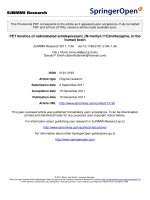Kinetics of Enzyme Reactions
Bạn đang xem bản rút gọn của tài liệu. Xem và tải ngay bản đầy đủ của tài liệu tại đây (421.47 KB, 16 trang )
Kinetics of Enzyme
Reactions
Srbová Martina
E+S
k1
k-1
ES
kcat
rapid
E+P
slow
reversible reaction irreversible reaction
Rate of the conversion of substrate to products (S → P):
v = kcat [ES]
Michaelis-Menten Equation
1. The ES complex is in a steady state.
2. All of the enzyme is converted to
the ES complex.
3. Rate of formation of the products
will be the maximum rate possible.
Vmax = kcat[E]total
Turnover number
number of molecules of substrate that
one molecule of the enzyme can
convert to product per unit time V
max
kcat =
[E]t
v=
Vmax [S]
[S] + Km
Michaelis
constant
Lineweaver-Burk Plot
1
v
=
Km
Vmax
•
1
[S]
+
1
Vmax
Multisubstrate reactions
1. Ternary-complex mechanism
Random mechanism
Two substrates A and B can
bind in any order
P,Q - products
Ordered mechanism
Binding of A is required
before B can bound
2. Ping-pong mechanism
Substrate A reacts with E to produce product P which is
released before the second substrate B will bind to modified
enzyme E´. The substrate B is then converted to product Q and
the enzyme is regenerated.
Enzyme activity
Standard unit of enzyme activity (U) [ µmol / min ]
-
amount of enzyme that convert 1 µmol substrate per 1min
SI unit Katal (kat) [mol /s]
- amount of enzyme that convert 1 mol substrate per 1s
Factors which effect enzyme activity
temperature
optimum for human enzymes
is between 35 – 45 °C
pH
Reversible Inhibition
Competitive Inhibition
E+S
ES
E+P
+
I
plus inhibitor
EI
no inhibitor
Competitive inhibitors bind at
substrate binding site and
compete with the substrate for
the enzyme
Noncompetitive Inhibition
E+S
plus inhibitor
no inhibitor
ES
+
+
I
I
EI + S
E+P
EIS
Noncompetive inhibitors
bind at a site other than the
substrate binding site
Uncompetitive Inhibition
E+S
ES
E+P
+
I
EIS
Uncompetitive inhibitors
bind only with the ES
form of the enzyme
Irreversible Inhibition
Irreversible inhibitors cause covalent modification of the
enzyme
Toxins: e.g. Amanitin (Amanita phaloides)
Diisopropylfluorophosfate (DFP)
- binds to the serine in the active site ⇒ deactivation of ezyme
eg .inhibition of acetylcholine esterase
Penicillin inhibits bacterial transpeptidase
Control of enzyme activity
1.
Allosteric enzymes
Negative feedback /feedback inhibition
A
E1
B
E2
C
E3
D
2. Covalently modulated enzymes
zymogens
undergo cleavage to
produce an active enzyme
Glycogen
phosphorylase
3.
Isozymes
- catalyze the same reaction
- differ in AA sequences, catalytic acitivity (substrates/coenzymes
affinity..)
Lactate dehydrogenase
tetrameric, 2 types of subunits M, H
M4, M3H, M2H2, MH3, H4
Glucokinase
x
↑Km
liver
not inhibited by Glc- 6P
Hexokinase
↓Km
mostly in the other tissues
inhibited by Glc- 6P
Thank you for your attention
